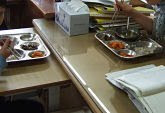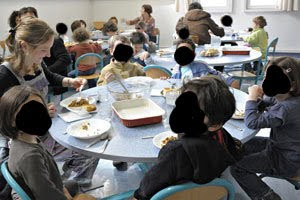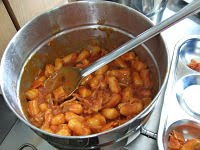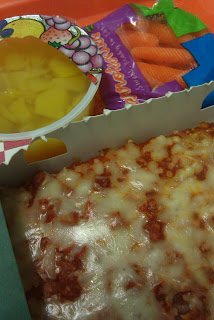Monthly Archives: April 2010
Day 59: meatball sub
Today’s menu: meatballs in sauce, whole wheat bun, peas, peach/pineapple fruit cup, milk (not pictured since I don’t drink it)
I haven’t had this one for a relatively long time! The sandwich wasn’t bad. I could have done without the fruit cup. I still believe that every lunch should get a piece of fresh fruit instead of a fruit cup or fruit “equivalent.” Do you save money with a fruit cup? Can anyone explain that to me?
Day 58: chili
Today’s menu: chili, green beans, tortilla chips, orange
I thought the chili was a touch spicy today, which surprised me in a good way. The green beans were flavorful in that they tasted like I would prepare at home and I found myself savoring them. And having fresh fruit is a pleasure. The school lunch gods smiled down at me today.
Guest blogger: Korean School Lunches
Hello all, I’m an American teaching ESL in Incheon, South Korea. I teach in a largish public elementary school, grades 3 through 6, and have about 650 students (30 students per class, 6 classes per grade, with a two-week rotating schedule. Ah!).
First, there is no cafeteria. Lunch in served in the classroom with the homeroom teacher present. Extra teachers, like me, eat lunch in the science room with the principal and vice principal. Each lunch costs W2,180 ($1.95), and is prepared fresh by the kitchen staff. There is usually nothing in plastic (I’ve only seen seaweed and yogurt drinks in plastic).
Each classroom has a cart with metal pots full of food, and metal chopsticks, spoons, and trays. The kitchen staff delivers the carts to each floor and then the students push their cart to the classroom. Everyone eats lunch at the same time for 50 minutes. This is also considered recess. I should mention that classes are 40 minutes long with a 10 minute break between classes. Students can do anything they want in that 10 minutes. They usually run, scream, gossip, and wrestle in the hallways. It’s 10 minutes of chaos.
 The menu always consists of some form of rice, soup, meat, vegetable, kimchi, and sometimes fruit. Purified water is available in the hallway (no milk, no knives!). Surprisingly the food rarely gets cold. And if they run out of food (the kimchi was particularly good that day), one student will run to the kitchen and get some more. Leftover soup and food is dumped into a different pot. I believe they use some of it for compost. There is no ‘trash can’, and many times I’ve carried around a napkin all day trying to find a trash can!
The menu always consists of some form of rice, soup, meat, vegetable, kimchi, and sometimes fruit. Purified water is available in the hallway (no milk, no knives!). Surprisingly the food rarely gets cold. And if they run out of food (the kimchi was particularly good that day), one student will run to the kitchen and get some more. Leftover soup and food is dumped into a different pot. I believe they use some of it for compost. There is no ‘trash can’, and many times I’ve carried around a napkin all day trying to find a trash can!
Today’s lunch was rice with bits of corn, seaweed/tofu soup, rice cakes with spicy sauce, cabbage kimchi, and stir fried beef with carrots.
Sometimes teachers complain that the food isn’t spicy enough. I asked why and they told me it’s because some students can’t handle spicy food. Personally, I don’t like eating rice and kimchi every day, but nobody seems to complain about that.
 Lastly, here is a picture of a student eating across from his homeroom teacher. I know that some other public schools in Korea serve lunch in a cafeteria with each grade eating at a different time. But even then they always have fresh food cooked by the kitchen staff.
Lastly, here is a picture of a student eating across from his homeroom teacher. I know that some other public schools in Korea serve lunch in a cafeteria with each grade eating at a different time. But even then they always have fresh food cooked by the kitchen staff.
If I had a choice I would choose the Korean meals over whatever Mrs. Q is eating. The pizza posts alone make me cringe.
**Thanks so much to our guest blogger from Korea! She can be reached at: almalibre3(AT)gmail(DOT)com**
Health update
Since there have been questions about how I’m doing….
Weight
Last time I updated you, I had gained one pound. So if my pre-project weight was A, then I was A + 1. As of a very recent doctor’s visit, I am now A – 2. I lost three pounds in a month, which is negligible.
I attribute this to natural weight fluctuations of +/- 5 pound from water weight. It could be I’m not eating everything with the same excitement I had when I first started the project. Now I have trouble finishing all of the food. Furthermore, it could be explained by Spring weather as I am getting outside to walk more than a few months ago. I’d also like to point out that I’m working even harder to eat healthier outside ofschool.
The absolute number of what I weigh right now doesn’t tell you how healthy I am. Just like I discussed in the Framing Obesity post, I might weigh a whole two pounds less than I did more than three months ago, but I might be less healthy at the cellular level. At the end of June I’m going to get another panel done to see what if any changes occurred. Having the summer as a break is really critical to me getting through this year of school lunches!
Headaches
I’m having very mild headaches that come on late afternoon/early evening. I find myself popping tylenol with dinner. In trying to brainstorm what it could be, I realized that I have been eating a little more chocolate here and there (Valentine’s and Easter). I was basically convinced it was the chocolate until I forced myself to cut it out and, well, low-grade headaches are still coming on. I’m going to drink even more water and see if that helps.
One Billion Live Bacteria
If you don’t want to read about my digestion — stop here. I changed my daily diet by eating school lunches and as a result I had a little more discomfort than before. I didn’t want to reveal that health info (IBS) to you guys, but I wanted to be honest about everything digestive. With those new tummy issues, I decided I needed a referral to a gastroenterologist. This particular doctor must be popular because I basically had to wait a whole month to get in. But I’m happy to report that it was worth the wait.
The gastro put me on this over-the-counter probiotic. I take one pill a day and each one contains a staggering one billion live bacteria. It is making a difference for me – I’ll leave it at that. And I think it will help me to be able to continue eating these meals without as many unpleasant side effects. I think that’s a good thing!?!
In case you were wondering I did not mention the project to the gastroenterologist because I just didn’t know how to phrase it. “So anyway since I’m eating school lunch every day…” or “Yes, so now that I’m eating school pizza once a week and…” or “Ever since I started eating processed meat for lunch…” How does one segway into that kind of discussion?
Fatigue
I feel very tired. I can’t say it’s the lunches though because I am basically working a full-time job, coming home to parent, to cook, and to straighten the house up, and then I sit down when everyone is sleeping and I blog. It’s like working a 16 hour day. I rely on getting naps in on the weekends to recharge.
Concentration and focus
I do find myself fading mid- to late-afternoon at work and I’m pretty hungry by 3:30 pm. I keep snacks in my car that I nibble on while driving home. I eat almonds, walnuts, and cashews as well as granola bars. The nuts give me protein to fill me up and balance out my blood sugar so that I can make it to dinner.
To summarize
Like I have said before how I feel is not as important as how my students feel. Their lives outside of school are big question marks for me. I know some family dynamics for various students and I wonder what they are (or aren’t) eating when they get home. I just don’t know. I can only guess.
Open thread: Childhood obesity
I really hit a nerve with my Framing Obesity post. Here’s your chance to share your opinions and experience and discuss causes and solutions. Please be sensitive about your comments (I should know – sorry).
Day 57: pizza
Today’s menu: pizza, carrots, peach fruit cup, milk
If I created a life-sized collage of me using photos of all school lunches I’ve eaten, I think my arms would be made of pizza and carrot sticks would be my fingers. One leg would be beef patties and the other chicken. My shoes would be whole wheat buns! A torso of fruit cups with my head and neck composed of chicken nuggets and cheese sandwiches. Tater tot and hot dog belt, pasta for hair, apples and pears for breasts, miscellaneous veggies for facial features and bananas for earrings. I am what I eat!
"Here!"
My school attendance was pretty good when I was a kid. I remember hearing my name read by the teacher in the morning and raising my hand. I always knew the name that came before mine alphabetically and I would listen for it. I loved school, but I was quite shy.
Every couple years my family moved cross-country because my parents couldn’t decide where to live. As a result I had to navigate new schools and make a whole new set of friends. Going to school wasn’t too hard for me because I found learning fun in spite of having difficulty socially as a perpetual new student. I was lucky because my parents valued education and praised me for my good grades. My mom said, “you are going to college: you will love it,” while my dad said, “you can be the garbage man as long as you are happy.”
The experience of school lunch for a new kid is basically hell and it’s not about the food. Every day there was the stomach churning search for a friendly face. I dreaded lunch for the first couple weeks, but then I would establish a tentative friend group and it would get better. But at least I didn’t have to go to school for my best meal of the day. My parents were able to provide me with a bagged lunch when I wanted one and then would give me lunch money if I wanted to purchase hot lunch.
The reason I bring up attendance is that when Jamie Oliver changed school lunches in the UK, absences went down (among other good things). That makes sense when you think the students are healthier and are sick less frequently. But what if you conceptualize food as a reward? Knowing I could go to school and get a high quality meal might be enough to get me up and dressed if I was a kid who needed that kind of motivation.
Furthermore, did you know that schools get monies based on Average Daily Attendance (ADA)? One way to help your school obtain more funding is to boost attendance. Could more money be a side benefit of better school lunches? How funny would it be if during roll call students said “Here! I’m here for the food!”










